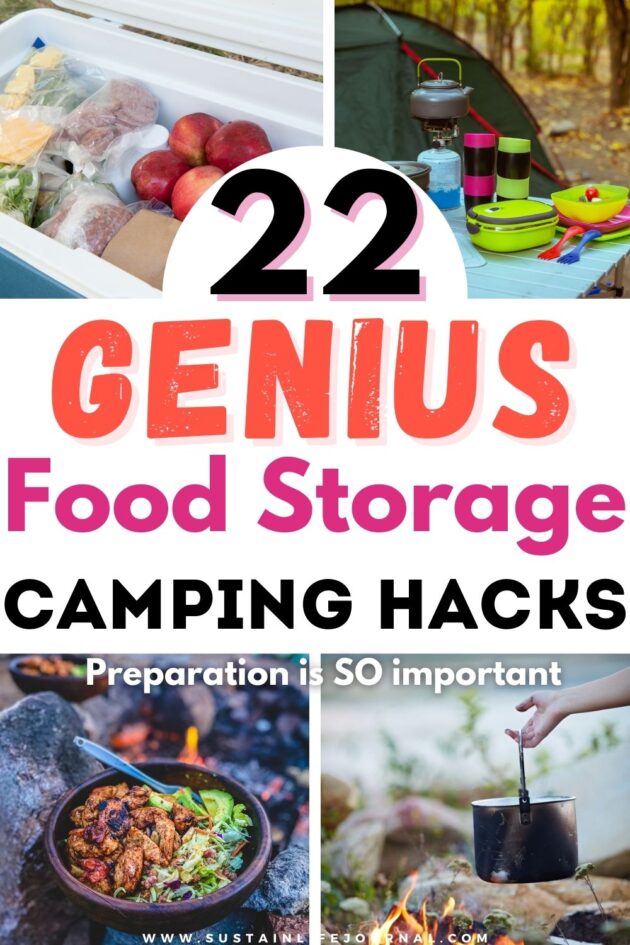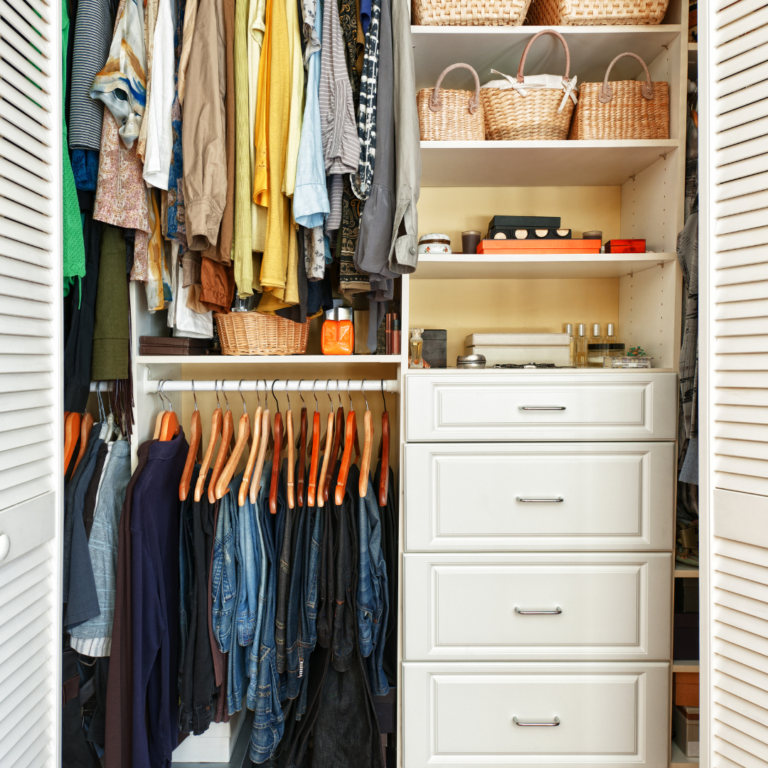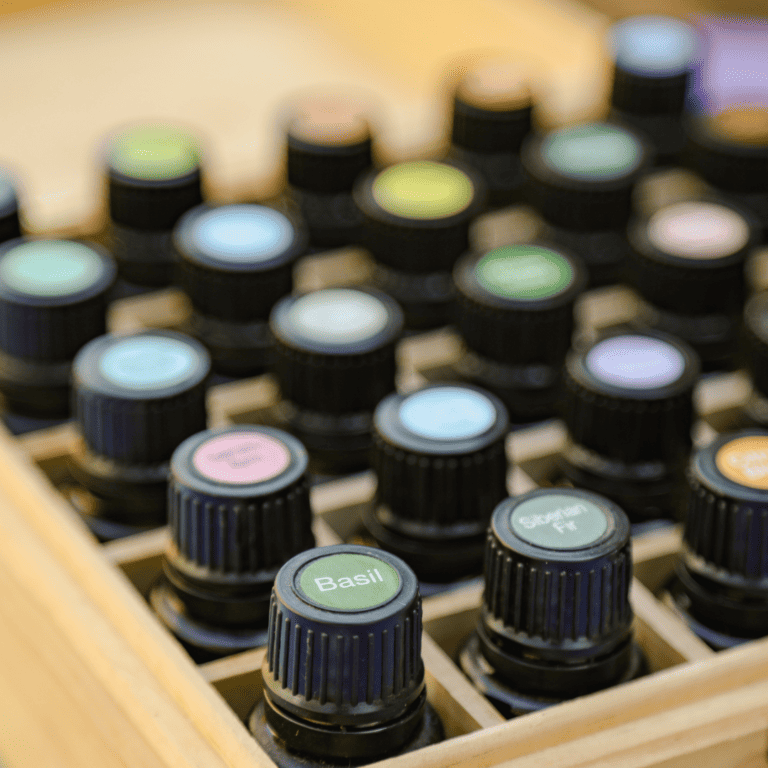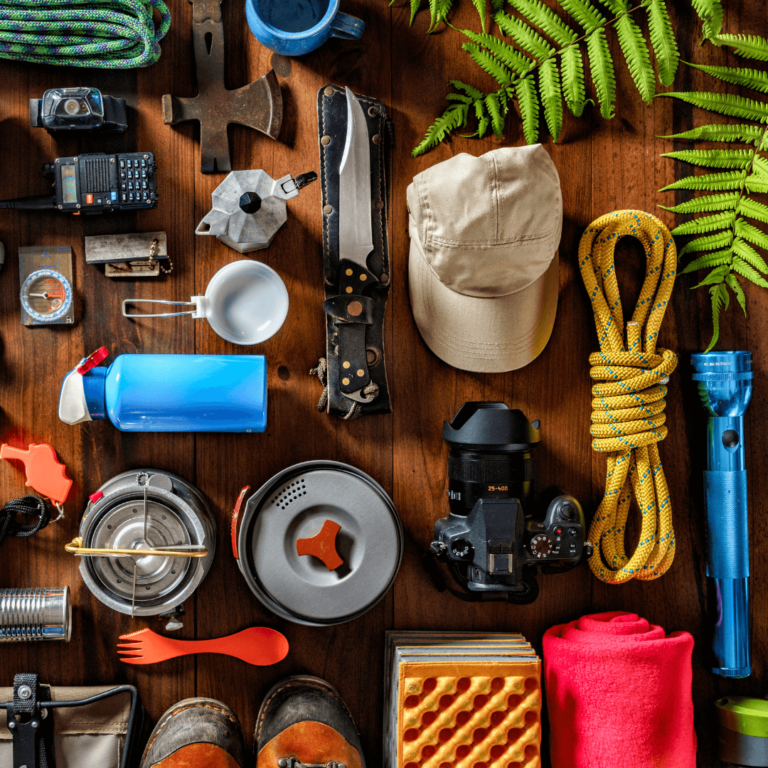8 Genius Camping Food Storage Ideas For an Organized Camp Kitchen
Before you head out on your next big adventure, flip through this list of camping food storage ideas to ensure your camp kitchen is organized and your food stays fresh!
Camping is the time to relax in nature, practice your hobbies, and connect with your loved ones. It can be so frustrating to feel overwhelmed by disorganized camping gear, no plan for your meals, and worst of all if an animal or the rain gets into your food.
This list will teach you all the best ways to create an efficient camp kitchen so that you can easily access all of your food, keep it organized, and ensure it is safe from animals and the elements.
*This post is great for those looking to do a weekend trip, short hikes, car camping etc. Not so much for those going into the remote wilderness for extended camping trips.
This post is all about the best camping storage ideas for your camp kitchen.
Why is it important to store your food properly when camping?
- Maintain food quality and good hygiene
- Minimize the risk of attracting wild animals or insects
- Provides easy access to food to stay organized
- Keep it safe from the elements (rain, sun exposure, snow etc.)
- Proper disposal of food packaging
- Minimize food waste by planning out your meals, keeping your camp kitchen organized, and only packing what you need
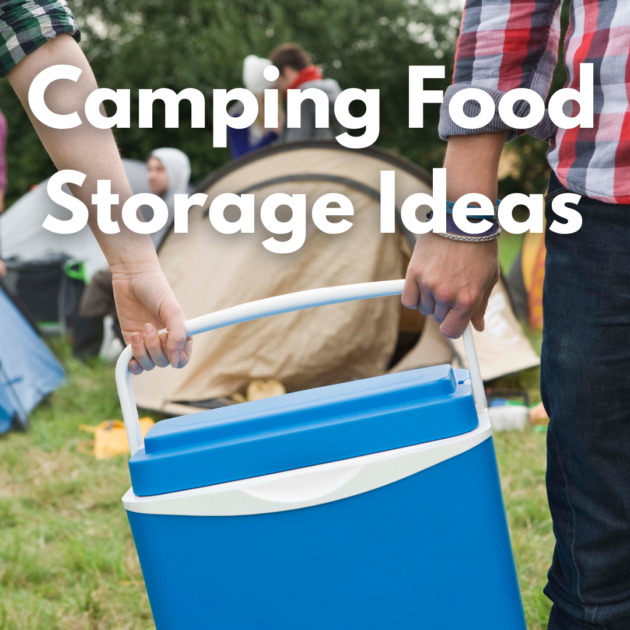
Important things to consider when storing food while camping
- Follow the “leave no trace” principle of not littering. Try to leave your campsite and the surrounding areas as you found them.
- Don’t store food in your tent so that you do not attract animals
- Have a plan for disposing of food properly or storing food waste until you can make it to a trash can, recycling bin or compost bin
- Make a meal plan for your food, cook as you can beforehand, and freeze it! One-pot meals are great for this i.e. soups, curries, stews, stir fry, burrito mixtures etc.
- Keep cold foods and dry foods separate
- Don’t leave dirty dishes out. Make sure they are thoroughly cleaned immediately after use. This will help to cut down on the amount of bugs near your campsite.
- Try to clean up any food that has been dropped around your campsite
- Opt for nonperishable items to save space in your cooler. Dehydrated meals, dried fruits and veggies, canned goods, prepackaged snacks, nuts, and more are all great options to start with.
- Make sure everything is sealed properly and labeled. Be mindful of water (and moisture!) and sun exposure as these elements can spoil your food and tarnish packaging.
- Don’t forget good hygiene when preparing food. Make sure to pack hand soap, dish soap, and/or hand sanitizer. I love Dr. Bronners Castile soap because it is multipurpose!
- Make sure you have a fire extinguisher and first aid kit accessible to everyone in case of burns etc.
If you follow the best practices for food storage tips listed above you will be good to go!
Don’t feel pressured to buy everything on this list! Use what you already own whenever possible or thrift camping gear when possible.
Here are some more important things to consider when storing and organizing food while camping, and also some creative tips for food storage while camping!
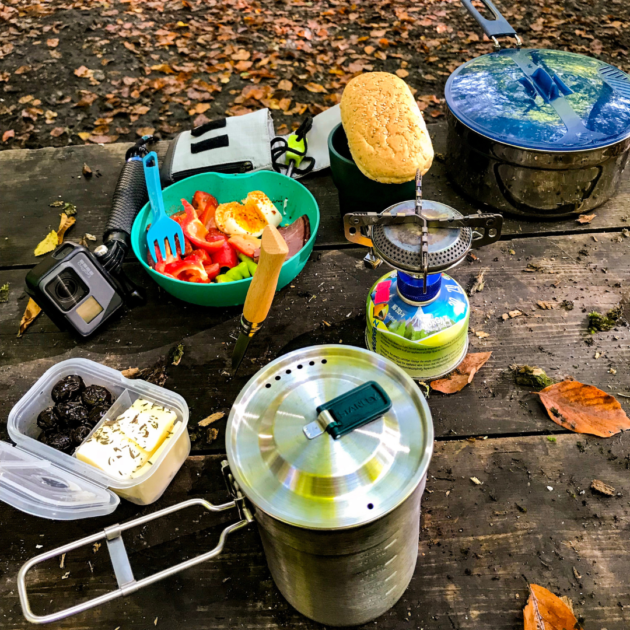
Best Ways To Store Food For Camping
1. Plastic containers and plastic bins
Plastic containers are the perfect way to organize all of your camping gear, especially when it comes to storing food.
Normally on this blog, I would not advise opting for plastic but it is useful in terms of keeping your food protected by outside elements. If you have limited space, using a plastic container (and stacking them!) can help to keep your campsite (car or RV as well) tidy.
Be sure to wash them out after use and take good care of them so you can get the most use out of them and not have to toss them in the landfill!
It’s a good idea to create a camp kitchen gear set with your camping cooking utensils all packed together. Here is a list of basic kitchen utensils to have in this container:
- Can opener
- Collapsable mixing bowls
- Reusable containers (can be used to eat out of as well)
- Water bottles & mugs
- Knives
- Cutting boards
- Bag clips, rubber bands
- Rubber tongs, spoon, spatula, serving spoon etc.
2. Bear canister to prevent wildlife from smelling your food
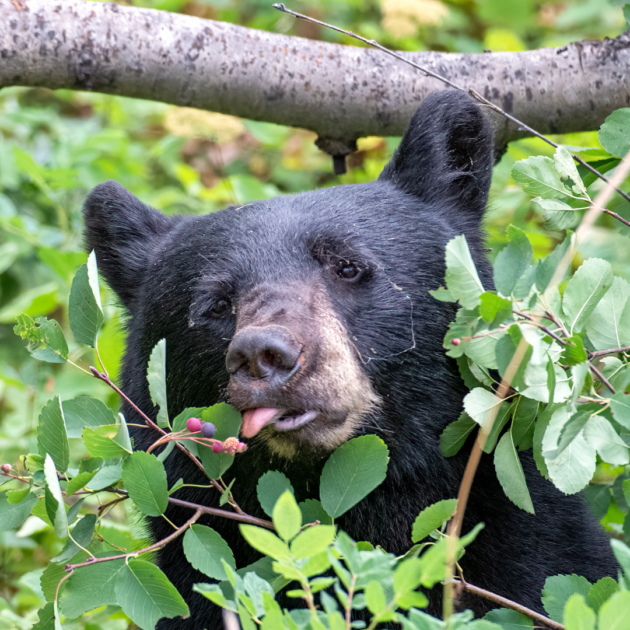
One of the best ways to keep your camping food safe is to lock it up in bear boxes!
To keep your food safe from bears and other hungry wildlife, check out these bear-resistant containers.
They have a hard outer shell to hold in smells and to protect your food, toiletry items etc. Anything that smells delicious to wildlife can be stored in these containers to keep your campsite pest and wildlife-free.
They are incredibly difficult for animals to crack open and don’t have latches so the likelihood fo them being carried off is minimal.
3. Coolers with ice packs to keep food cold while camping
For any perishable foods, you will need a high-quality cooler with ice packs. There are so many to choose from and of course, so many things to consider like the size of the cooler, having wheels, backpack option etc.
I suggest going for Yeti coolers because they are incredibly durable and popular for a reason. It is a big investment up front but if you take good care of it you can keep it for years!
If you can’t quite invest in a Yeti cooler, consider trying out these eco-friendly ones. They won’t keep your food cold as long but they are great for an overnight camping trip or just general food organization of nonperishable items.
A trick I love to do when camping is freeze my Stasher bags before camping and use them as ice packs in my cooler. That way when they eventually melt you can use the bags for food storage.
Always keep food safety in mind if you are storing things like raw meat, dairy products etc. Your cooler needs to stay below 40 degrees Fahrenheit.
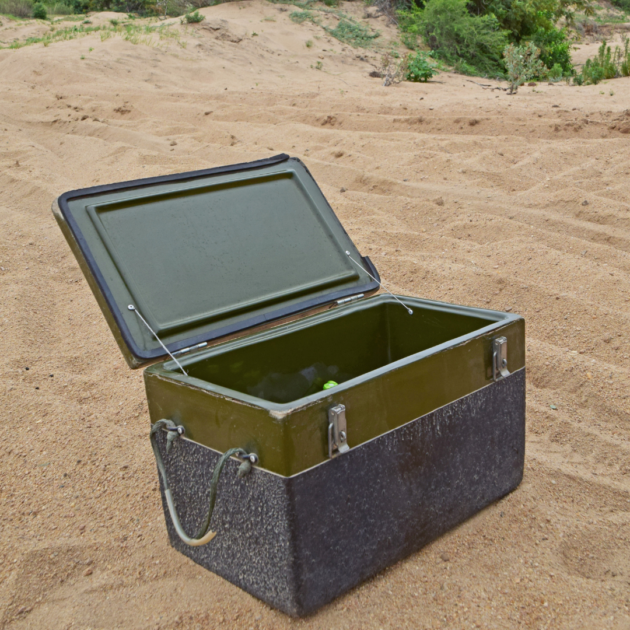
4. Craft box/tackle box to store small items
The possibilities are endless when it comes to using these boxes to store food-related items while camping
- You can use them as mini Lunchable containers to section out snacks for kids (or adults!)
- Use them to store utensils, spices, sugar, creamer pods etc.
{RECOMMENDED POST: The Best Vegan Protein Bars You Need To Stash In Your Gym Bag}
5. Hanging food bags
Another way to deter wildlife from getting to your food is to hang it in a sturdy tree branch.
Be sure to get it as high as safely possible and away from the trunk of the tree. Also, ensure that you use a waterproof bag since tree coverage will only do so much if it rains.
6. Use a ketchup bottle to hold pancake batter
Before heading out, measure out the amount of dry pancake batter you will need and put it in a clean (and dry!) ketchup bottle or other upcycled food bottle.
That way when you get to your campsite you can just add water to the bottle and squirt out the batter from your bottle! It is a great way to upcycle a plastic bottle and helps to cut down on cook wear to wash i.e. measuring cups, mixing bowl etc.
7. Dry bags
Dry bags are basically a must have when it comes to storing food while camping.
They are so incredibly helpful to protect your food from the elements. You can even stash them in your bear canister for extra protection.
These are great to take with you hiking, kayaking etc. to prevent snacks or electronics from getting ruined.
8. Use Go Toobs for condiments, sauces and spices
Rather than packing full-size bottles of your favorite condiments, consider measuring out your ingredients into Go Tubes. They will keep your products individualized and they have a similar cap to most condiments.
Gotubes are easy to wash, don’t leak, and are pretty sturdy. These also work great for toiletries.
9. Vacuum-sealed bags
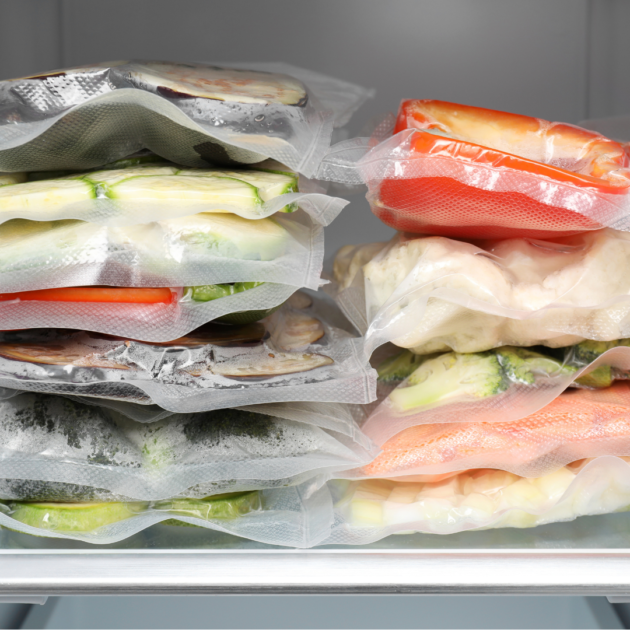
If you have a large volume of food you want to keep protected and organized, vacuum sealed bags are incredibly helpful.
You can either use these large packing bags or these smaller vacuum sealed bags to meal prep individual meals.
These bags help to reduce the volume of your food and extend its shelf life. This odor-proof bag will ensure your whole car or campsite doesn’t smell like your meal prepped meals.
The larger bags are great for organizing clothes as well!
10. Mesh food storage bags
I love to use mesh food storage bags for prepackaged snacks. The bags are breathable and can be hung and stored in cool dry spots.
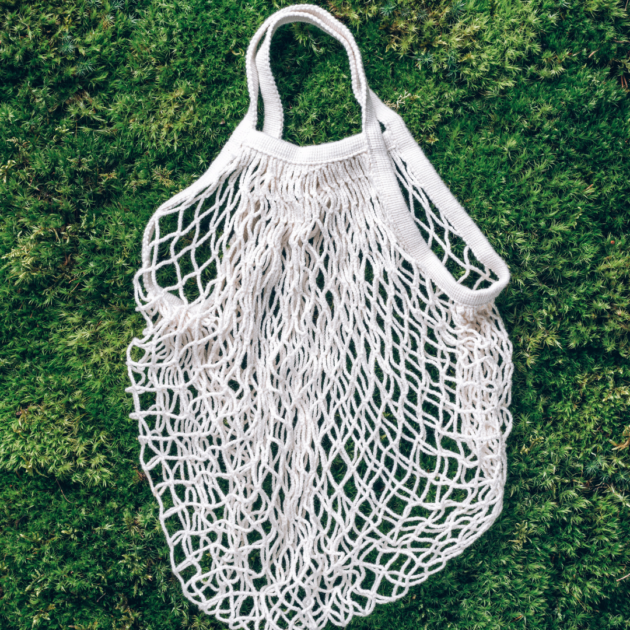
11. Plan out your water storage and access to water
Most campsites will have access to water but make sure to have extra water with you and jugs to carry it. In the wilderness, it is always better to be over-prepared.
- Life straw for emergencies
- Water jug with a spigot
- Reusable water bottle
- Bucket for extra water near your campfire
12. Food storage buckets
If you don’t want to buy a bear canister or want a more affordable option, head to your local hardware store and pick up a bucket that has a tight sealing lid.
These are great for storing things like pasta, beans, and rice to ensure there is no chance of water exposure. They come with a handle and can be easily moved around, are relatively affordable, and can be stacked to save space.
13. Reusable silicone bags
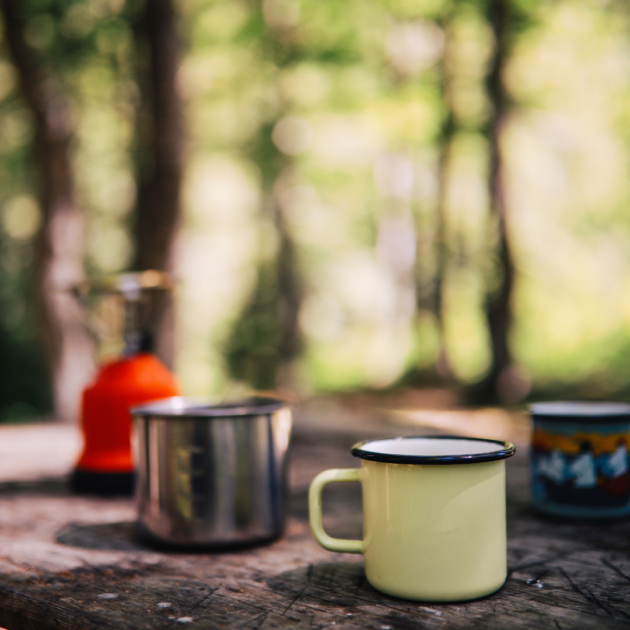
Plastic bags are normally a go to for organizing food while camping but consider swapping them for the eco-friendly alternative, the reusable silicone bag.
There are so many different silicone bags on the market but the only ones I use are Stasher bags. The seal is really tight, you can easily clean them and reuse them and they can store all kinds of things (even nonfood related!)
- Precook meals before camping. Meal prepping is a great way to make meal times efficient and stress-free. Soups are a great option to prepare beforehand, seal it in your silicone bag, freeze it, and then bring it in your cooler!
- They can act as a dry bag if you are bringing snacks on a canoe ride, hike etc.
- Can keep utensils organized and clean
- Overnight oats
- Hold coffee grounds, tea bags, lemonade mix & other drink mixtures,
Stasher sandwich bags are a must for your camping pantry!
{RECOMMENDED POST: 9 Camping Organization Ideas For An Organized Camping Trip}
14. Use frozen water bottles as ice packs
To be mindful of limited space, consider freezing water bottles overnight to use in your cooler as ice packs. Then when they thaw out they can be used for drinking water!
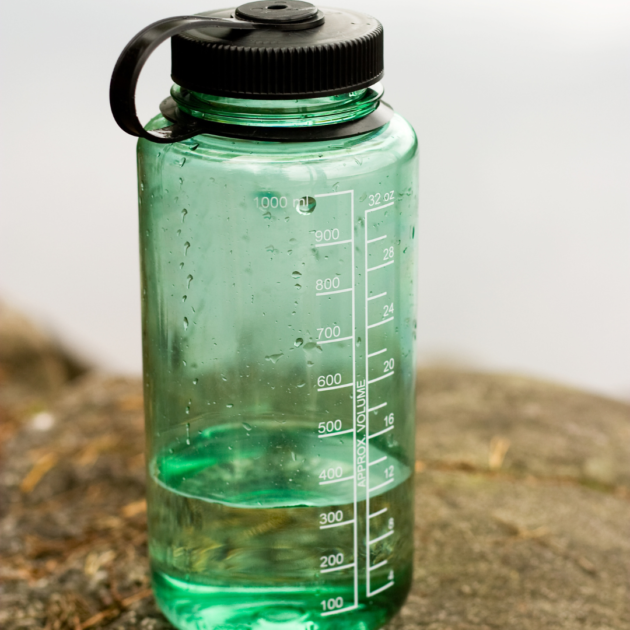
15. Use a collapsable sink to wash dishes and store dishes when not in use
A very helpful multi-use camp kitchen item is a collapsable sink. It is easy to stash away and it can be used to hold kitchen items when you are not using it. Make sure to let it air dry before folding it up so ensure it doesn’t get moldy, smelly or have food trapped.
16. Separate and label everything
One of the easiest but most impactful tips when it comes to storing food while camping is to keep everything organized and clearly labeled. This is especially helpful if you are camping with a lot of people, to prevent cross-contamination and allergic reactions.
Whether you want to use a label maker or a good ol sharpie and duct tape, be sure to have all of your food storage bags labeled so that when people are hungry (or hangry!) you can easily access your food and get to cooking.
17. Bug covers
Once you have your spread laid out on the picnic table, don’t forget to use a mesh food cover.
These are great to use if you are preparing multiple ingredients and you can throw them over your cutting board. A simple dishtowel will do but these will fully cover your bowls and plates.
18. Use a stainless steel food storage containers
I am obsessed with the reusable containers from Ukonserve because they are made from stainless steel and silicone.
Since they are made from stainless steel and not glass they are super light and easy to carry around. The seal of the silicone lid is also pretty tight and I haven’t had issues with things spilling.
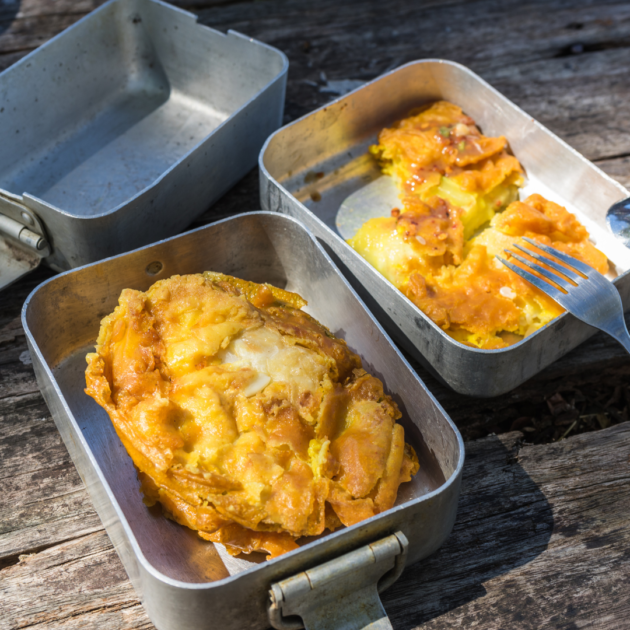
19. Don’t forget trash bags
As you focus on food prep, don’t forget about food disposal. Before your hiking trip you can start collecting bags to repurpose and use as trash bags.
- Bread bags
- Paper bags from grocery stores
- Plastic produce bags
- Ice bags
- Food packaging (like chip bags)
These are all great ways to reuse items before they head to the landfill. Or if you would like a more traditional trash bag, check out these eco-friendly bags.
20. Skip the meal prep, storage, cooking etc., and bring a few pre-made meals on your camping trip
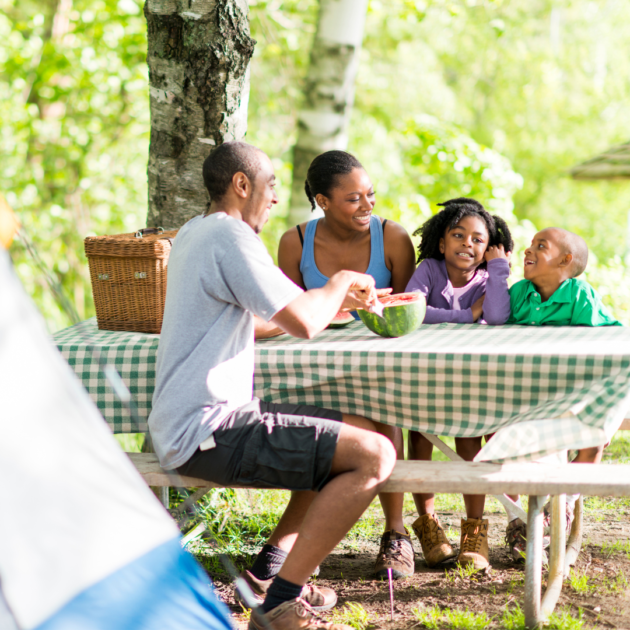
If you love cooking then this tip is not for you. There is no shame in simply bringing some store-bought meals to throw in a pot to eat. It will of course give you more time to appreciate nature’s beauty etc. They can also taste pretty good as well!
Here are some really tasty pre-made meals that make camping a breeze:
21. Use a mesh laundry bag to dry your dishes
Once you have washed up your dishes, place them in a mesh laundry bag to air dry and ideally dry in the sun.
This will keep meal times organized and efficient while also keeping your cutlery and cooking utensils clean.
22. Don’t forget dish towels
Dish towels can have multiple uses while camping and are a wonderful way to cut down on the use of paper towels.
You can use them to wrap up silverware to keep them organized, use them as napkins, and placemats. At the end of your stay you can use them for cleaning. Some messes require disposable paper towels but most don’t!
Food storage with car camping
A lot of the tips above are interchangeable with food storage while car camping but there are a few other things to consider:
- Keep your food food out of sight. Make sure it is tucked away in your car so animals can’t see it.
- Make sure your windows are closed so that animals cannot smell your food or gain access to it.
- Don’t store food in the bed of a truck or strapped to the outside of the vehicle. Again, this is just an open invitation to wildlife to snag your groceries.
Do you have any other creative camping food storage ideas? Let us know in the comments below! I’m sure others in the community would love to learn from you for their next camping trip!
Be sure to sign up for the newsletter if you would like sustainability and wellness tips sent directly to your inbox!
Stay well,
Maggie
This post was all about the best camping food storage ideas.
Other posts you may like:
5 Simple Connections Between Sustainable Living On Your Debt Free Journey
9 Clever Bike Storage Ideas For Apartments To Maximize Space
The Best Foods To Dehydrate For Snacks
If you would like to save this post for later-Pin it!
